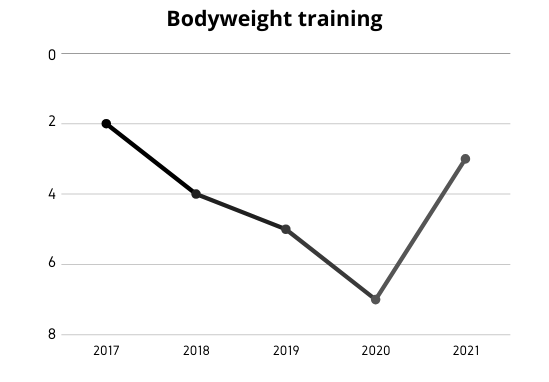Embrace the coming trends of 2021 and ensure good client retention.
2020 was a year like no other for our industry. Adapting to the regularly changing guidance from the UK government has changed our exercise habits, with many embracing online training sessions from their own personal trainers or following classes from fitness trainers, such as, Joe Wicks. Similarly, many have taken to exercising outdoors.
As a fitness professional, it is crucial that you know what is predicted to be popular in the upcoming year so you can focus your skill development and class offerings on areas that are going to attract the most clients. The American College of Sports Medicine (ACSM) received responses from 4,377 health and fitness professionals who are connected to the ACSM brand to find out what they think the most popular trends will be for 2021. Responses came from all over the world: Australia, Brazil, Canada, China, France, Germany, Japan, India, Italy, Russia, Singapore, Spain, Taiwan, United Kingdom and the United States.
2021 Results
| 2021 Rank | Trend | 2021 Rank | Trend |
| 1st | Online training | 11th | Health/wellness coaching |
| 2nd | Wearable technology | 12th | Mobile exercise app |
| 3rd | Bodyweight training | 13th | Employing certified fitness professionals |
| 4th | Outdoor activities | 14th | Functional fitness training |
| 5th | High intensity interval training (HIIT) | 15th | Yoga |
| 6th | Virtual training | 16th | Exercise for weight loss |
| 7th | Exercise is medicine | 17th | Group training |
| 8th | Strength training with free weights | 18th | Lifestyle medicine |
| 9th | Fitness programs for older people | 19th | Licensure for fitness professionals |
| 10th | Personal training | 20th | Outcome measurements |
HIIT

In the past five years, high-intensity interval training (HIIT) has continually stayed as one of the three top trends. Is it the flexibility of this training style or is it the intensity? We speak to co-founder and CEO of HIIT Science Paul Laursen to investigate this.
He says, “Firstly, it has an extremely potent effect at enhancing aspects of health and performance potential over other training strategies. Second, it’s a time-effective training strategy. Most individuals don’t have two or three hours to devote to training; they can, however, get results in only one or two short sessions of less than 30min duration when done correctly. Third, depending on how HIIT is done, you can target specific energy systems in just the right dosage, allowing a targeted approach to the physiological responses you are after. For practitioners that know how HIIT works, this is incredibly efficacious and of high value to their clients.”
Outdoor activities

In a normal year, you would have outdoor workout classes and bootcamps in the summer but, once it got colder, many would head inside. But, with the home becoming the new office, getting outdoors has become a welcome break, which is likely why it was ranked the fourth most popular trend this year.
We reached out to fitness expert and creator of the unique audio/video walkout session SWEATCOIN WALK, Dean Hodgkin, to better understand this trend’s jump from 13th position in 2020 up to fourth. In the UK, along with the soft-touch, community feel of the marketing for Parkrun and the increasing number of outdoor bootcamps, including some very professional models now on offer, obviously lockdowns have played a big part in this year’s success.
He has seen from his own experience and within research that “exercisers who ran outside and focused on the environment felt less anxious, tired and depressed than indoor runners.” For most of us leading an indoor lifestyle, especially this year, getting outside provides a necessary release from this.
Bodyweight training

Bodyweight training has stayed in the top 10 in the last five years. It has slowly been losing popularity each year and, in 2020, it ranked seventh. However, due to the events of last year, bodyweight training has become more popular, as it was one of the few things people could do due to social distancing and hygiene guidelines. Many asked in the survey believe it will be the third highest trend for 2021.
We explored what the future may hold for bodyweight training with FitPro’s national trainer manager and ViPR education manager, Aaron Barnett. He thinks a large part of why it has remained within the top 10 in the past five years is because “a trainer doesn’t need to invest in kit and location can be completely flexible. I feel the growth in the trend this year is coupled with the boom of online training. During lockdown, it has been a trend without barriers and limits. With a little creativity and strategy, trainers can plan and progress their clients without excuses.”
He thinks “coaches will need to continue to grow their expertise and knowledge in this field to maintain the popularity of this trend. Bodyweight training can become boring pretty quickly if a trainer struggles for ideas and understanding in this trend.”
Wearable technology

The continued popularity of wearable technology willlikely be no surprise. This trend has stayed as one of the top three trends for the last five years and only missed out on the top position this year due to Online Training.
In times like this when we can’t be together in person, wearable technology has allowed fitness enthusiasts to stay connected in other ways through challenging each other and tracking their own and friends’ progress.
We reached out to Dave Wright, chief executive officer of wearable heart-rate monitor company Myzone, to better understand this trend’s popularity. Over the past year, he has seen how valuable having data has been. Moving forward he believes; “the ongoing desire for developers and designers is to meet the customer where they are’. The other thing to bear in mind is that the acceptance that wearable technology is here to stay means that there is a greater attention to learn how to best apply it, rather than dismiss it.”
Online training

We have all had to become experts in online training in the last year to continue supporting our clients. We spoke to FitPro’s managing director Jane Waller to get her insights on this trend and discuss what the future will be for online training. This is what she had to say:
“Many professionals in the industry have had to adapt their business models to embrace the online space almost overnight. At the beginning, we heard from our members, ‘how stressful adapting to online training was’. Many had only ever delivered their personal training or group exercise sessions in person, so it was a challenge moving to a digital offering and also knowing how much to charge for their only online services due to the perception some had that working out online was a lesser experience.”
“However, after almost a year of delivering in this way, we have seen how many have adapted and learnt best practice for online training, and we have seen great examples of polished and engaging online classes. The true test will be if people will continue to train this way or do a blend of online and in-person training once our industry starts to reopen.”
To conclude
While the ACSM’s survey produced insightful data, it is global so it may not reflect your unique market. We hope this information is useful in planning for the coming year and that it encourages you to explore new avenues in your education and career.
Do you agree with our industry leaders’ comments or even the survey itself? If you have an opinion, then please do get in touch via email: info@fitpro.com







